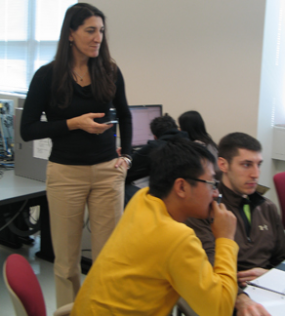Flipped class energizes CFD
By Mark DwortzanTwo . . . one . . . zero. Change!

Prof. Barba provides one-on-one attention to students at workstations, occasionally peppering them with leading questions such as "Is that your best plot of the pressure?"
Clutching an iPhone, Assistant Professor Lorena Barba (ME) works a brightly lit computer lab at the Photonics Center like a Hollywood movie director, cueing her ENG ME 702—Computational Fluid Dynamics (CFD)—students to take their places on the set of what she calls the “Navier-Stokes Speed Dating Game.”
As the action unfolds, five of the 10 graduate students and seniors in attendance—selected at random by an app on Barba’s iPhone—remain at their workstations and display their software solutions to a physics problem using the classic equations that describe fluid motion. The other five pair off with a succession of three-minute “dates” at each workstation, compare notes, and select the date with the most impressive solution. The winning programmer then projects his code and graphical results on a whiteboard at the front of the room, sparking a lively discussion about its merits.
The scene departs dramatically from what took place in last Spring’s version of the course, when Barba delivered a lecture on the same topic, deriving equations on the whiteboard as students mainly listened and took notes. That’s because this year she decided to “flip the class,” posting videos of lectures online for home study and using class time to guide highly interactive, collaborative problem-solving sessions that clarify concepts presented in the lecture—i.e., the “homework.” Rather than deliver information from on high, she meanders through the room, offering an occasional leading question to help a student get unstuck, or facilitating a conversation about the relative advantages of different approaches to the problem at hand.
From Lecture to Workshop
“Creating an active and engaged learning environment is automatic when flipping a class, and with today’s technology for creating multimedia learning materials, it can be done without losing any of the content,” maintains Barba, who made the switch by editing 40 hours of lecture videos that she had already recorded and posted on iTunes U for students in previous incarnations of the CFD course. “In fact, it is the perfect use of technology for education.”
It takes more than technology, however, to implement a flipped classroom successfully, she observes.
“The challenge of the flipped model, I have found, is designing the class activities by which the students are led to discover the important concepts, and explain them to each other. During these activities, the instructor can walk among the students giving them personalized attention, sometimes giving a tip or asking a question.”
While the flipped classroom strategy has been around for more than five years, the widespread availability of online video technology has recently accelerated its adoption in schools and colleges across the globe. Also driving its use is a growing body of empirical studies that underscore the ineffectiveness of the traditional lecture. Informed by these studies, a recent President's Council of Advisors on Science and Technology report concluded that flipping the classroom, active learning and other more dynamic teaching methods are essential to producing sufficient numbers of science, technology, engineering and mathematics (STEM) graduates to maintain U.S. preeminence in STEM fields.
Creating an active and engaged learning environment is automatic when flipping a class, and with today’s technology for creating multimedia learning materials, it can be done without losing any of the content.
Upgrading the Learning Experience
For Barba’s students, the flipped classroom has not only captivated their attention, but also deepened their command of the subject matter.
“Class meetings are active, engaging, and encourage cooperative learning,” said Brad Garner, a LEAP student pursuing an MEng degree in mechanical engineering. “Watching condensed versions of traditional lectures at home allows me to reinforce the concepts demonstrated in class without sacrificing the ability to ask questions of Professor Barba or my classmates.”
“The biggest upside to the ‘flipped classroom’ concept is that it provides a structured platform for peer-to-peer learning; every class is like a study group,” added Andrew Wixom, a first-year PhD student in mechanical engineering. “In our class, everyone helps out and the coding projects feel almost like a collaborative effort.”
Barba credits the approach for improving student performance. “Last time, students usually had a bug or more in their code during their final presentations and never fixed them afterwards,” she recalls. “This time, nearly all are discovering and correcting their errors way before their presentations. Nearly everyone’s code works, leading to much more relaxed, creative presentations.”